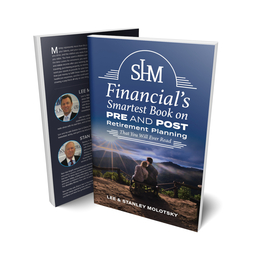
For one South Jersey father-and-son duo, the early days of COVID lockdown were an opportunity to update their first book, 2015’s Exit Strategies for a Secure Retirement. But Stan and Lee Molotsky—president/CEO and managing partner of the 64-year-old SHM Financial Group, respectively—soon realized they had a whole new book on their hands.
That new book is SHM Financial’s Smartest Book on Pre and Post Retirement Planning that You’ll Ever Need, which Stan Molotsky says addresses “where we are and where we’re going” while tapping into the full-service retirement planning firm’s many advisory offerings.
Retirement planning is a heady, deeply personal and infinitely individualized process Molotsky says can be distilled into a basic approach—LIVE, or longevity, inflation, volatility and events—in this latest book.
“The concept is: How do you live while you’re preparing for pre- and post-retirement?” Molotsky explains. “It gets to the meat and potatoes of what one should do prior to and when they are in retirement in a shorter, one-sitting read.”
Each chapter tackles those foundational elements, and so does Molotsky.
On longevity and retiring in unprecedented times:
“With what we’re going through at the present time, you have to be much more nimble than you may have been in the past and keep your mind open to some of the newer things available now. A retirement plan is not a like drafting a will: You can’t just do something, stuff it in a drawer and forget about it.”
On building your retirement team:
“You have to look at your plan and make tweaks to it as you move along. … Make sure you have a team of people—your CPA, your attorney, a financial advisor—who you can utilize to help you implement the things that you want to do. You can only do some much yourself.”
On safety and risk in retirement planning:
“You have red money and green money. The red money has risk and that much greater return, but also has the possibility of loss. The green money, which is protected, will be there no matter what. … We’ll keep looking at what your risk tolerance is and making adjustments along the way.”
On the nuts and bolts of a retirement income plan:
“No. 1, you have to know what happens to your money if something happens to one spouse or the other. No. 2: Where are you allocated and should you be in those allocations today? Forget what’s happened in the last 10 years: What do you think is going to happen over the next three to six to 12 months? … How do you think [national and international events] are going to affect what you’re doing and spending? What is all that going to mean to your asset base, and how are we going to protect you no matter what happens?”
On smartly protecting your retirement:
“As you get closer to retirement and the first year or two into retirement, one of the things you’ll want to do is make sure you have enough liquid assets—or things you can turn into liquid assets—available in a short period of time to get you through six, 12, 18, 24 months without having to touch your core investments that are parked away.”
On maximizing social security:
“Everybody’s different, as far as should you wait until you’re 72, should you take it at 70, should you take it at 65? And then there are different things that you can utilize based on what your other assets are to tell you if you should take it earlier or later. … When you’re in your 60s, when you’re just starting to look at what you might want to do, you have to consider that the longer you wait, the higher the number will be—but if you take it earlier, you have the use of that money, which you could invest and, hopefully, do as well if not better in generating a higher income.”
On tax planning:
“It’s very critical: How are you going to protect yourself as taxes go higher? Well, you put money into certain things that are tax-free or things like a Roth IRA or a traditional IRA, and you look at balances as to when you should move money into one or the other. You put money into an IRA, you get a deduction in that contribution—it’s not taxable in your current income stream—but when you take it out, it’s fully taxable. Are you going to be in a lower bracket or a higher bracket when you take money out?”
In addition to all of the book’s proceeds supporting the Jewish Federation of Southern New Jersey’s special-needs endowment fund, its goal is to help everyone reach—and enjoy—their most rewarding retirement scenario.
Molotsky notes that, in terms of providing for your legacy, there are many approaches that ensure your money goes into the appropriate charitable organizations and family trusts. But he advises his clients to never feel guilty about providing for their own needs first.
“I encourage them to spend some of the money on themselves as quickly and as often as possible,” Molotsky says. “Your kids will be fine. My goal is to make sure that you—the client—take some of this money that you’ve worked so hard for and enjoy it on yourself.”
SHM Financial: 1010 Haddonfield-Berlin Road, Suite 305, Voorhees
SHM Building: 100 Richey Ave., Collingswood
(800) MONEY-SHM
SHMFinancial.com
Published (and copyrighted) in Suburban Family Magazine, Volume 13, Issue 9.
For more info on Suburban Family Magazine, click here.
For information about advertising in Suburban Family Magazine, click here.
To find out where to pick up your copy of Suburban Family Magazine, click here.




